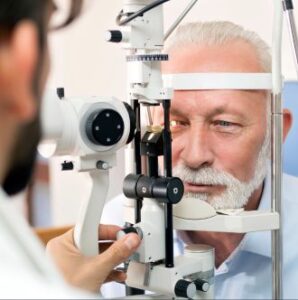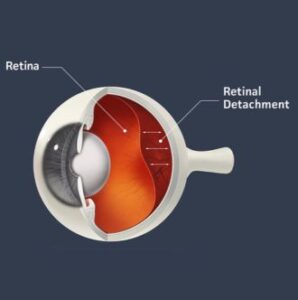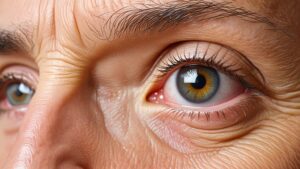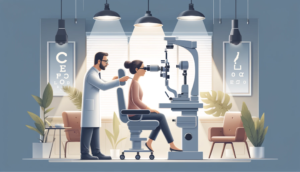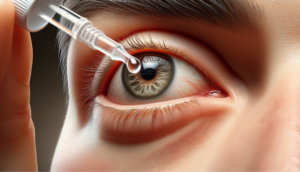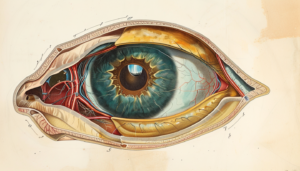The lens is the clear structure at the front of the eye that refracts or focuses rays of light to go through to a specific point on the retina at the back of the eye. The retina then converts this light energy from the outside world to electrical energy that is transmitted via the optic nerve to the brain. If the lens becomes cloudy the light can get dispersed (less focused) and the image that is focused on the retina is no longer clear, causing people to begin to notice problems with their vision. This clouding of the lens is known as a cataract.

Cataracts occur when proteins in the eye cause the lens of the eye to become cloudy, resulting in impaired vision.
A normal, healthy lens is generally clear. It is composed of water and protein fibers within a thin capsule. The lens fibers normally migrate from the edge of the lens (periphery) to the center, which means that the center of the lens (nucleus) is the area composed of the oldest protein fibers and the newly formed fibers are at the outermost area (the cortex). [1]
When changes to these proteins or lens fibers occur, a cataract can develop or “grow.” Often, cataract formation is described as an aggregation (clumping) of the proteins within the lens. The degree of vision loss depends on where in the lens the cloudiness is located and the size of the cloudy area.
How many people have cataracts?
An estimated 24.4 million people over the age of 40 in the United States have a cataract in either eye and this number is estimated to rise to 30.1 million by 2020. [5] Approximately half of all Americans over the age of 75 either have cataracts or have had cataract surgery.
Causes of cataracts
- Advancing age / exposure to oxidative stress
- Genetic factors / family history
- Lifestyle factors (smoking, significant alcohol consumption, obesity)
- Eye injury (trauma, chemical injury, electrical injury)
- Eye inflammation
- Eye surgery
- Other eye conditions (glaucoma)
- Ultraviolet radiation from sunlight and other sources
- Systemic diseases/disorders (diabetes, hypertension)
- Medications (corticosteroids, statin medications for cholesterol, hormone replacement therapy)
- Radiation exposure (occupational or from certain cancer treatment)
Common myths about cataracts
- Cataracts are NOT caused by overusing or straining your eyes.
- Cataracts cannot move from one eye to the other.
- Cataracts are not contagious.
- Cataracts have no association with the Cadillac brand of cars.
What is oxidative stress and how does it cause cataracts?
Oxidative stress occurs when there is an imbalance between free radicals and antioxidants in your body. We are exposed to free radicals every day. They are oxygen-containing molecules that have an uneven number of electrons which allows them to easily react with other molecules. When they react, they can cause large chain chemical reactions in your body, called oxidation. In some instances, this oxidation can be harmful and is known as oxidative stress. Having been exposed to an excess of free radicals over time can cause lens proteins and lipids in the eye tissues to become damaged or disorganized. They then accumulate in the lens, leading to progressive clouding and cataract formation.
Antioxidants are molecules that can “give” an extra electron to the free radicals, without harming their own structure and can help prevent oxidative stress.
Cataracts are classified according to their cause
Age-related cataract (senile cataract) is the most common type of cataract to occur in adults. They typically begin to develop between the ages of 40 and 55 years of age. The clouding of a normal, healthy lens in this type of cataract is a direct result of oxidative stress.[6]
Age-related cataracts can be divided into three groups, depending on the location of the opacification (cloudiness) in the lens. It is not uncommon for more than one type of cataract to be detected in one eye.
- Nuclear cataract (center of the lens) – clouding of the nucleus, located in the very center of the lens. People typically experience darkening of their vision or it is appearing yellow or brownish. Some people have reported a temporary improvement in their ability to see things at near (objects at two feet or less, or with activities such as reading or knitting) without reading glasses when nuclear cataracts first develop. This phenomenon is referred to as “second sight” and unfortunately, the improvement disappears as the cataract worsens and becomes more developed. If you notice an improvement in your ability to read or perform near activities without using reading glasses, you should consult with your eye care professional. Often, this improvement in near vision is accompanied by a worsening of distance vision.
- Cortical cataract (outer edge of lens) – clouding of the layer of the lens that surrounds the nucleus. These types of cataracts have a wedge or a spoke-like appearance, with the cloudiness starting at the edge and extending to the center of the lens.
- Posterior subcapsular cataract (back of the lens) – clouding of the furthest back, outer layer of the lens (under the lens capsule). Posterior subcapsular cataracts usually develop more rapidly and tend to occur in younger people.
- Traumatic cataracts can develop following a blunt or penetrating trauma to the eye. A cataract will form because the injury caused a disruption to the lens fibers in the eye. Cataracts are estimated to occur in up to 65% of eye trauma cases. [2] A traumatic cataract can develop immediately after an eye injury or even years after an injury.
- Pediatric cataracts can develop in one or both eyes, depending on their cause. Approximately one third of pediatric cataracts have an inherited cause, another third are caused by abnormalities of the eye, often due to a systemic syndrome, and another third occur for unknown reasons (undetermined cause).
- Congenital cataracts are lens opacities that occur at birth or shortly after. They are rare occurrences and may have an inherited (genetic) cause or may develop due to an infection (such as rubella) that the mother had during pregnancy. Congenital cataracts can lead to permanent blindness by interfering with the ability to focus light on the retina and resulting in failure to establish appropriate communication between the retina and the infant’s brain.
- Infantile cataracts are lens opacities that occur during the first year of an infant’s life.
Can medications cause cataracts?
Certain medications have been shown to be associated with cataract development.
- Corticosteroids – Long-term use of corticosteroids, by any route of administration (oral, injectable) has been strongly associated with cataract formation, particularly posterior subcapsular cataracts. Notably, treatment of allergies with oral steroids or long-term use of topical or inhaled steroids may also cause posterior subcapsular cataracts.
- Neuroleptic (antipsychotic) medications such as chlorpromazine and several other phenothiazine neuroleptic drugs appear to induce cataract formation.
- Busulfan, an anticancer drug often used in the treatment of leukemia, has been shown to induce cataract formation.
- Statins for cholesterol – Studies have shown that people who take statins are at a 9-27% increased risk for developing cataracts. [3]
Are certain diseases or disorders associated with cataract?
Diabetes – People with diabetes typically develop cataracts at younger ages than non-diabetics. People with poor glucose control often develop cortical or posterior subcapsular cataracts that may progress rapidly in a short period of time.
Myotonic Dystrophy – Approximately 90% of people with Myotonic Dystrophy (genetic disorder that affects muscle function) develop cataracts in their third decade of life. In some cases, the cataracts are detected before the diagnosis of myotonic dystrophy is made.
Hereditary disorders – There are dozens of genes that have been shown to play a role in cataract development. Many of these are associated with other abnormalities, developmental syndromes or conditions (Lowe syndrome, neurofibromatosis type 2, Rieger Syndrome, Norrie disease).
Inflammatory diseases – Disease that cause chronic inflammation in the body of ten require long-term corticosteroid treatment. Cataracts develop as a consequence of long-term corticosteroid treatment.
What are the Risk factors for Cataract development?
Some risk factors that may increase your risk of developing cataracts include:
- Increasing age
- Diabetes – poor glucose control
- Excessive exposure to sunlight
- Smoking
- Obesity
- High blood pressure
- Previous eye injury or inflammation
- Previous eye surgery
- Prolonged use of corticosteroid medications
- Alcohol consumption
- Radiation exposure (occupational radiation exposure, radiation exposure during cancer treatment)
Can Cataracts be Prevented?
Scientific studies have not proven any treatments that can prevent or slow the progression of cataracts, although physicians do recommend that the following may be beneficial:
- Go for eye examinations regularly – Having a comprehensive (thorough) eye examination can help to detect cataracts and other eye problems at the earliest stages. Check with your regular physician or eye care professional to determine how often you should have your eyes checked, based on your age and overall health.
- Carefully manage your overall health or other disease or disorders – other health problems, such as diabetes, and medications can lead to cataract formation or other eye problems, so always follow your physicians’ advice to best manage your ongoing overall health.
- Stop smoking – Smokers develop cataracts earlier. Check with your physician about stop-smoking strategies and assistance that may be available and best suited to help you. The risk of cataract development slowly declines after you quit smoking, but unfortunately never returns to normal.
- Healthy food choices – A healthy, balanced, low-fat diet, including plenty of fruits and vegetables, helps to ensure that you are getting the best vitamins and nutrients for your body and there is evidence that a healthy diet may help reduce your risk of cataracts. Fruits and vegetables also contain antioxidants, which have been shown to help maintain the health of your eyes.
- Sun protection – Long-term exposure to ultraviolet B rays from the sun can increase risk of cataracts. Wearing sunglasses that block harmful ultraviolet light from the sun may help to preserve the health of your eyes. Wearing a wide-brimmed hat can also be helpful. Check to ensure that your sunglasses are labeled that they block ultraviolet B (UVB) rays.
- Reduce alcohol consumption – Excessive alcohol use can slightly increase the risk of cataracts. A study from Sweden showed that women who had one or more alcoholic drinks each day were 7% more likely than nondrinkers to required cataract surgery, and that surgery was required two years earlier.[4]
References:
[1] Bobrow JC, Breadsley TL, Jick SL, et al. Lens and cataract. San Francisco: American Academy of Ophthalmology, 2015–16. https://www.aao.org/assets/9c6f2834-24c7-428a-a004-6f09048254a0/636312524130900000/bcsc1718-s11-pdf
[2] Insler MS, Helm CJ (1989) Traumatic cataract management in penetrating ocular injury. CLAO J 15: 78-81. https://www.ncbi.nlm.nih.gov/pubmed/2917402
[3] Leuschen J, Mortensen EM, Frei CR, Mansi EA, Panday V, Mansi I. Association of statin use with cataracts: a propensity score-matched analysis. JAMA Ophthalmol. 2013 Nov;131(11):1427-34. https://www.ncbi.nlm.nih.gov/pubmed/24052188
[4] Lindblad BE, Håkansson N, Philipson B, Wolk A. Alcohol consumption and risk of cataract extraction: a prospective cohort study of women. Ophthalmology. 2007 Apr;114(4):680-5. https://www.ncbi.nlm.nih.gov/pubmed/17173974
[5] The Eye Diseases Prevalence Research Group. (2004, April). Prevalence of cataract and pseudophakia/aphakia among adults in the United States [nei statistics and data]. https://www.ncbi.nlm.nih.gov/pubmed/15078665
[6] Vinson JA. Oxidative stress in cataracts. Pathophysiology 2006; 13: 151–62 https://www.ncbi.nlm.nih.gov/pubmed/16765571

